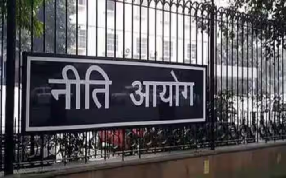India needs to strive to be a USD 30 trillion economy by 2047 with a per capita income of USD 18,000 per annum to become a developed economy, NITI Aayog has said in an approach paper ‘Vision for ‘Viksit Bharat @2047’.
According to the paper, which was discussed in the NITI Aayog meeting on Saturday, India needs to avoid the middle-income trap. The paper said that Viksit Bharat is envisioned to be built on the three pillars of ‘Demography, Democracy and Diversity’.
Prime Minister Narendra Modi chaired the Ninth Governing Council meeting of NITI Aayog. The paper said that studies have shown that barely a dozen middle-income countries have broken out to become develop high income countries in the last 70 years. “Progressing from a middle-income to a high-income level requires sustained growth in the range of 7-10 per cent for 20–30 years.
Very few countries have managed to do this. The reasons have been well analysed and include structural, institutional, and other socioeconomic factors. As a nation we need to avoid this trap and carefully work towards breaking out of it,” the paper said.
“As for the economy, to become a developed nation, we need to strive to be a USD 30 trillion economy by 2047 with a per capita income of USD 18,000 per annum. The GDP would have to grow nine times from today’s USD 3.36 trillion and the per capita income would need to rise eight times from today’s USD 2,392 per annum,” the approach paper said.
Referring to the tangible gaols for Viksit Bharat, the paper said that on the demographic front, India can aim for raising the average life expectancy to around 84 years. “The Total Fertility Rate (TFR) will be gradually declining to about 1.80 and the population stabilising at about 165 crores by 2047.
Being a youthful nation, the working age population would be around 112 crores, making it the single largest workforce of any nation in the world. In a similar manner, we can aim for tangible goals on some basic parameters such as literacy and health with a target of universal literacy and a very low Infant Mortality Rate (IMR),” it said.
For Bharat@2047, the paper projects a median population age of 37 years. In terms of social profile, it calls for 100 per cent literacy rate, over 70 per cent female labour participation (from current 37 pc), 100 per cent skilled workforce and top 10 in global gender equality.
In terms of economic profie, the paper calls for over USD 18,220 per capita GDP, 34 per cent industry contribution to GDP and 55 per cent reduction in carbon emission intensity from 2005 level. “These goals are just a few illustrative examples of what our nation should aim to achieve.
There should be similar goals in all spheres of life, be it for individuals, for the economy or for governance. It is only the steadfast pursuit of these goals across all spheres of human endeavour that will enable India to become a Viksit Bharat. Team India will have to work together to realise this Vision by strategizing, planning and implementing policies, programmes and interventions in a spirit of cooperative federalism,” the paper said.
The paper said that Viksit Bharat represents “our collective vision to transform India into a developed country where each individual will live up to her/ his potential with meaningful lives and livelihoods, and the entire society and economy will flourish.”
“As India stands at this crucial juncture, poised to take off on its growth trajectory, it is important to realise that tremendous dedication and belief in India’s destiny is necessary to realise this potential. There is enormous work that needs to be undertaken in a mission mode to achieve the vision of a Viksit Bharat by 2047.”
“Business as usual will not do. We must create the future. It is important to channelise our innovative ideas into actions. There must be a sense of purpose, dedication and steadiness to use the Amrit Kaal in building a nation that our freedom fighters envisaged and sacrificed for….
“This has to be a collective endeavour of the Centre and States. Most of the actions in social sectors are to be done by States and a significant portion of capital investments too have to be done by States. We need to see that all States develop rapidly and also converge in their incomes and in the quality of life they are able to provide. We need to integrate all markets across the country, for goods, labour and capital,” the paper added. The approach paper also defines what is Viksit Bharat.
“It is a Bharat which will have all the attributes of a developed country with a per capita income that is comparable to the high-income countries of the world today. It is a Bharat whose social, cultural, technological, and institutional features will mark it out as a developed nation with a rich heritage and one that is capable of functioning at the frontiers of knowledge.
The World Bank defines high income countries as those whose annual per capita income is more than US $ 14,005 (in 2023). India has the potential and aims to be a high-income country by the centenary of its independence in 2047,” the paper said.
The paper talks of India’s transformation on many fronts, specially in the last decade, demonstration of quantum leap capabilities, unique advantages as also internal challenges that should be addressed.


